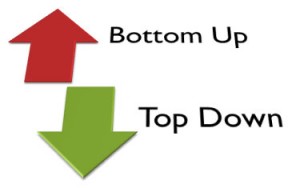Dickinson to Durban » Climate Change » “Top-Down” and “Bottom-Up”
“Top-Down” and “Bottom-Up”
By: Maggie Rees
Often spoken about in climate negotiations is “top-down” and “bottom up” models for climate policy. Such models are included in overall approaches for climate negotiations. As COP17 reaches nearer and nearer, I am attempting to have a complete understanding of as many negotiation terms, models, lingo, articles, and any other information to be in full-awareness while in Durban. My focus on “top-down” and “bottom-up” models first started this past weekend spent in Washington, D.C., and was extended while reading Harald Winkler’s Sustainable Development Policies and Measures (2002). An overview of “top-down” versus “bottom-up” models is presented below:
“Top-Down” Model
- Cohesive analysis of energy use and emissions
- Observes the larger economy
- Includes feedback effects concerning different markets
“Bottom-Up” Model
- Economic analysis of energy use and emissions based on the individual
- Programming issues with mathematics
- Describe technological advances and options in detail
- Capable of analyzing efficiency standards and control policies
- Does not account for changes in price, incomes, or the larger economy relations
Harald Winkler compares the two models by saying “Dividing a global reduction target among all countries (in a “top-down” manner) is only one possible approach. The alternative approach is pledge-based (in a “bottom-up” matter). The pledge could be to quantify emission targets, as in the Kyoto process, or more qualitative in nature. In such an approach, it is clear that countries negotiate in their self- interest, so each tends to propose indicators most beneficial to itself” (Winkler, 2002).
What are the possibilities for “top-down” and “bottom-up” models in the upcoming climate negotiations? Might it be a cohesive analysis of energy use and emission reduction techniques? Perhaps an individualized analysis would also suffice. Combining the two models to meet in the middle could be the best option. A hybrid of “top-down” and “bottom-up” might just form a happy medium.
Works Cited:
Blok, Kornelis, et al . “Economic Evaluation of Sectoral Emission Reduction Objectives for Climate Change.” DG environment, 2001. Web. <http://ec.europa.eu/environment/enveco/climate_change/pdf/comparison report._pdf>
Böhringer, Christoph, and Thomas Rutherford. “Combining Top-Down and Bottom up in Energy Policy Analysis: A Decomposition Approach.” ZEW, 2011. Web. <ftp://ftp.zew.de/pub/zew-docs/dp/dp06007.pdf>.
Winkler, Harald. “Sustainable Development Policies and Measures.” World Resources Institute. 2002. Print.
Filed under: Climate Change · Tags: bottom-up, Harald Winkler, Maggie Rees, top-down









Recent Comments